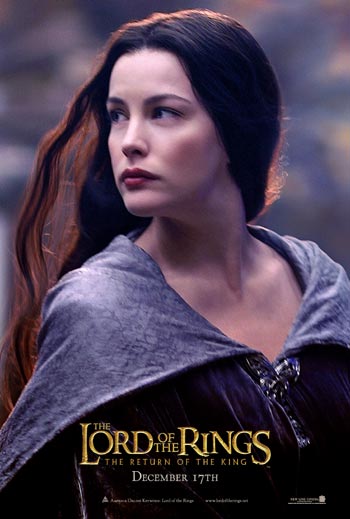Last time, I compared Galadriel and Shelob as opposite ends of the representations of female power. In my article series “Women and Chauvinism in Middle-earth”, I try to examine the interplay and representation of gender with a focus on female characters. Although it has been a while since my last one, I haven’t abandoned the article series. In this edition, my attempt is to examine Arwen and provide a closure for The Lord of the Rings before moving on to The Silmarillion next year.
 As one of the few female characters mentioned in LOTR, Arwen cannot be ignored even though most of what we know about her is in the appendix. In LOTR itself, her appearances are scarce. Often times, it is through the eyes of Frodo that the reader stumbles upon Arwen:
As one of the few female characters mentioned in LOTR, Arwen cannot be ignored even though most of what we know about her is in the appendix. In LOTR itself, her appearances are scarce. Often times, it is through the eyes of Frodo that the reader stumbles upon Arwen:
In the middle of the table, against the woven cloths upon the wall, there was a chair under a canopy, and there sat a lady far to look upon, and so like was she in form of womanhood to Elrond that Frodo guessed that she was one of his close kindred … So it was that Frodo saw her whom few mortals had yet seen; Arwen, daughter of Elrond …. The Fellowship of the Ring; “Many Meetings”
Once again, as in the case of Galadriel or most elves in general, Arwen is described as young “and yet not so”. Frodo just seems to observe Arwen but no interaction takes place. Michael Drout observes in his book JRR Tolkien Encyclopedia: Scholarship and Critical Assesment:
Like many of Tolkien’s vast dramatis personae, Arwen is sketched in a few lines, her actions more important than her inner personality … She appears by turns inspirational, remote, generous, and … watchful of the well-beings of others.
Interestingly, the next time Arwen appears is much later in The Return of the King, in the chapter “Many Partings”. The title of the chapter not only mirrors her first appearance, it is once again an encounter between Frodo and Arwen. During this encounter, the theme of self-sacrifice, begins to surface:
A Gift I will give you. For I am the daughter of Elrond. I shall not go with him now when he departs to the Havens; for mine is the choice of Luthien […] But in my stead you shall go, Ring-bearer, when the time comes, and if you desire it. ROTK; “Many Partings”
Here Drout argues that these sacrifices of “Elvish women who forfeit eternal life to die with their human husbands … are redemptive because they unite the two kindreds of Elves and Men”. Other than that, Arwen’s character seems not to have any other function than to marry Aragorn. In other words, her symbolic role is to elevate their marriage, and Aragorn’s kingship, to an act of destiny.
While I have to agree Drout’s assessment of Arwen, the effect of Arwen’s passiveness influences the reader’s perception of Aragorn. Leanna Madill observes in her essay “Gendered Identities Explored: The Lord of the Rings as a Text of Alternative Ways of Being” that the juxtaposition of stereotypical feminine traits such as passiveness, “women play an important role in developing the male’s sense of masculinity”. Of course masculinity is not the opposite of femininity as Madill observes. In the case of Arwen and Aragorn, the stereotypical association of male gender and masculinity and female gender and femininity seem to be dead-on. However, in the cases of Galadriel and Eowyn, a closer look reveals that both are described beyond simply feminine features as Madill explains:
Similar to Arwen and Galadriel, Eowyn is described beyond simply having typical feminine features. Her “long hair was like a river of gold”, but in the next sentence it says, “strong and stern as steel” ….
Leanna Madill, “Gendered Identities Explored: The Lord of the Rings as a Text of Alternative Ways of Being”
In other words, the stereotypical representation of the juxtaposition of femininity and masculinity is only observable at the surface level.
All in all, female characters in LOTR, are indeed scarce, but those few female characters still raise interesting questions of gender inequality, gender stereotypes and notions of femininity and masculinity. Another interesting approach would be to examine the role of male characters and the possible representation of different models of masculinity. For my analysis of the Silmarillion, I intend to examine notions of masculinity as well. This, however, will happen in the next year!


